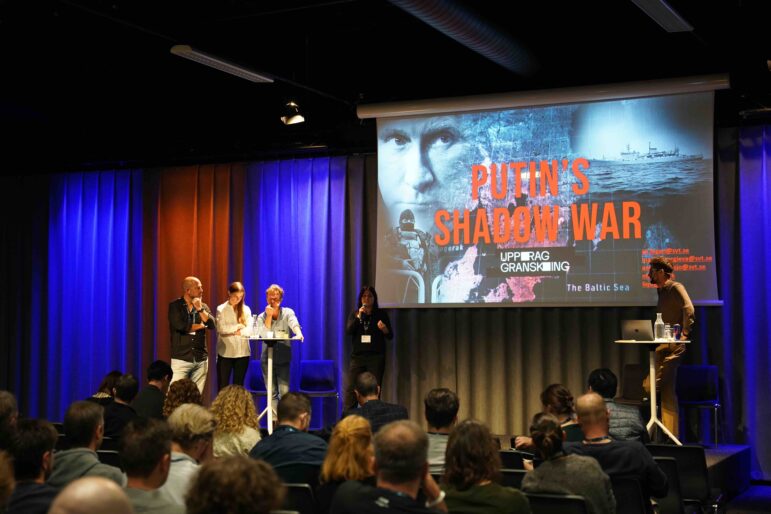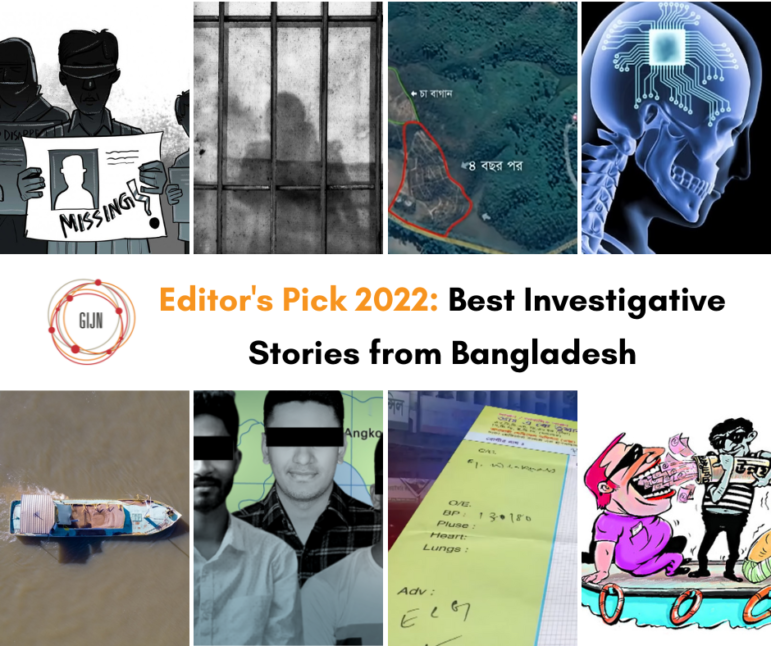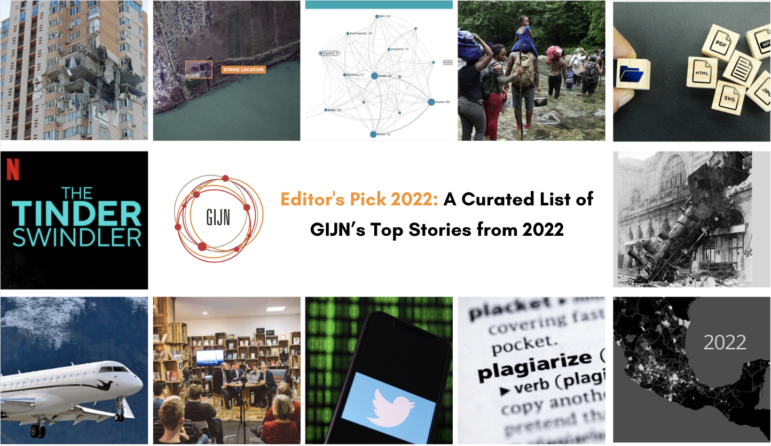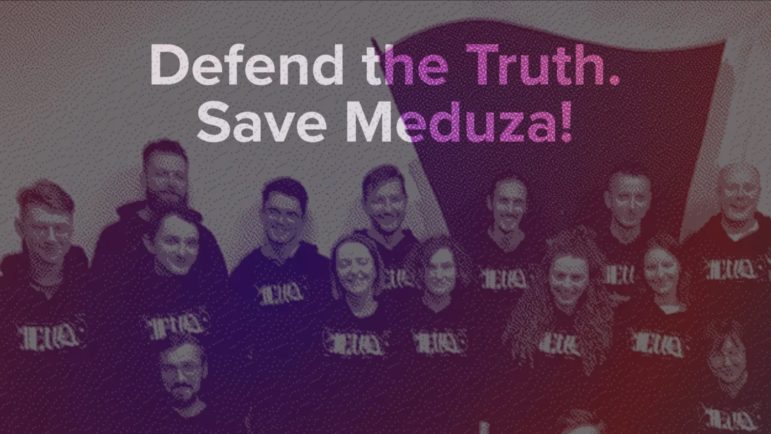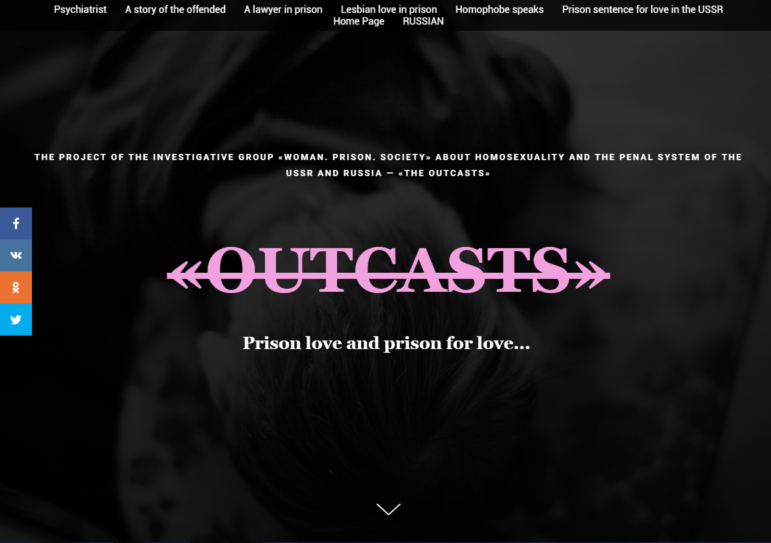

Cover page for the English version of "Outcasts," a story by the Women in Prison project. Screenshot.
Behind Bars: What Happened When a Russian Activist and a Journalist Collaborated

Screenshot of the English version of “Outcasts,” a story by the Women in Prison project.
Three years ago, Leonid Agafonov, a veteran human rights activist, participated in a workshop about producing investigative multimedia projects in the Russian city of Yekaterinburg. For one of the exercises, participants were asked to break into groups. There weren’t enough people in Agafonov’s group so journalist Natalia Donskova joined him. It didn’t take long for the two of them to meet again to start working on “Women in Prison,” an independent project which produces investigative stories around the lives of women behind bars. The series covers taboo topics which span health issues such as the treatment of cancer patients and childbirth in prison to sexual abuse and LGBTQI relationships.
The project has been nominated for the prestigious independent journalism prize Redkollegia and the Sakharov Prize, and was the winner of the Civil Initiative prize. It also won a competition of cultural and social projects concerning LGBTQI issues in Russia. Ilya Kudinov, who led the workshop for the Russian-based media development group Tak-tak-tak, spoke to Agafonov and Donskova for GIJN about their chance meeting and how it transformed into a high-profile investigative project, which now employs five staff members who have produced 13 investigations.
Here’s an edited version of their conversation.
Tell us more about how you started to work together.
Leonid Agafonov: Several months before the Tak-tak-tak training, I had gathered a lot of data proving that when migrants were placed in detention centers, children were removed from families. During the course of the workshop, Natalia and I used some of that data to create our first project, “Where is My Mother?”
But after the training I realized I needed the help of a journalist. I could prepare a lot of reports but I had neither journalism skills nor the desire to write. So I called Natalia and proposed we work together. She agreed.

Leonid Agafonov. Photo: Natalia Donskova
Natalia Donskova: Leonid impressed me with his dedication and the level of his knowledge around prisoners’ rights. Journalists often look for a suitable investigation for years, and I was lucky enough to meet an experienced specialist with perfect data and documents.
His proposal to work together happened at the perfect time. I had just decided to give up my job working for a TV news group. I was tired of one-day spots; I wanted to work on deeper stories. And I had been given a significant bonus before my resignation which is what allowed me to work pro bono for a period of time.

Natalia Donskova. Photo: Courtesy of Natalia Donskova
When did you decide to turn your initial collaboration into a long-term project?
Agafonov: We had already collected material on other topics. I had been a member of the public oversight commission for detention centers, and had visited many of them. When I left that job, I decided to continue working on the topic, focusing on gender and children’s issues in detention centers. It is a serious issue. Compared with other countries, we have a huge number of women in detention. But no one was dealing with the issue. So while our project started out as a rights protection initiative, it became an investigative one as well.
How did you succeed in implementing the project without any initial financing?
Agafonov: Initially, we worked without pay. Natasha worked in the Rostov Region, and I was in Saint Petersburg. I applied for a grant from a Russian nonprofit to work on our next project about oncology patients in prison hospitals. While we received the grant, it was so small that it didn’t even cover our costs. But we managed. Natasha used my air miles so she could come to Saint Petersburg and we could work together, while she stayed with a friend. It was difficult, but we managed to get things moving. By the time we completed our investigation, we had a resolution from the European Court of Human Rights confirming that the conditions of oncology patient care in prison hospitals were torture-like.
About a year ago, we participated in an event in Poland and were happy to obtain a traveling allowance of $200! Now, we have stable financial support from international and local partners. We received five big prizes and grants this year.
Is your project currently the only one in Russia that covers issues around women, children, and the infirm in detention facilities?
Agafonov: That’s right. When Natasha started to work for the project on a permanent basis, we expanded its subject matter. Now, we also examine the problem of LGBTQIs and those exposed to sexual abuse in prisons.
You hadn’t worked on investigations on the subject of prisons before, Natasha. What drew you to the subject?
Donskova: Let’s start from a purely pragmatic standpoint. Over the years, Leonid has accumulated a huge amount of research and documents which could be analyzed. It was an excellent opportunity for personal and professional growth. But our work is not just about the investigation – it is an examination of serious issues. Nobody is immune to violations by law enforcement. I don’t want to feel helpless in such cases. I want to know that some action is being taken to improve the situation. And I like working with Leonid. He’s a real professional.
How do you break up your work?
Donskova: Leonid is responsible for the expert assessment of a problem, while my task is to prepare material for the viewer. Production issues – organizing shoots, bringing in external experts, negotiating interviews – are shared between us. Leonid communicates with rights activists, advocates, and any other experts.
Agafonov: When we conduct interviews, we try to do it in a way that we can use that same material in the next two or three investigations. For example, during the story around oncology patients in prisons and prison hospitals, we decided to arrange two additional shoots; the woman at the center of our investigation was dying and we needed to make sure we had all aspects of her story. Now we are going to make a movie about it based on these interviews.

Human rights activist Leonid Agafonov (left) visits an oncology patient at a hospital prison. Photo: Courtesy of Natalia Donskova.
How do you decide on your topics?
Agafonov: We always have something ready to investigate that we think will resonate with people, and sometimes we cover something requested by the public. We also have topics that we examine on an ongoing basis; these are complicated and slow-paced, such as the stories on oncology or about the rights of LGBTQIs in prisons.
The most difficult part about our work is finding central characters who can help us tell a story. People in detention are afraid. We always take their security into account and consider whether it is possible to disclose a person’s history or not. For example, if we write about HIV and a person does not want to be named, we put that story aside and wait until a better time.
Also, some of our sources can be very shifty. If the person is ready to give us an interview today, we have to go and take it, even if it’s midnight. Because tomorrow it could be too late. That person can disappear, be imprisoned, or be on the run. We deal with a very unstable group.
Are there ever any disagreements about approaches to investigations because of your different backgrounds?
Donskova: We often have serious disputes. But we listen to each other’s arguments and then come to a mutual decision. For example, I often want to start a story as soon as possible. So, we discuss why it might be better to work on something else. We also argue about the structure of a story, or certain visuals or text. In Leonid’s opinion, the material could be inappropriate or change the story’s essence. But I might think that the material is innovative.
What is the main goal of the project?
Agafonov: We are focused on changing the system. For example, we have launched a petition about childbirth in prisons that has already been signed by more than 90,000 people!
Few people know how pregnant women and their children are treated in prison. Children are usually imprisoned together with their mothers. It’s not a child daycare center; the children stay in standard cells. The floor is not soft; the beds are not wooden, they are made of iron. There are a lot of problems, including injuries and overcrowding.
Thanks to our investigations, there have been some legislative initiatives. While the authorities don’t credit us, we publish our stories and they react to them. The Ministry of Justice has already ordered that pregnant women be set free in cases of non-violent crimes.
Are there specific cases that you are particularly proud of?
Donskova: Our oncology project has resulted in legislative changes. The authorities have expanded a list of people to be discharged due to illnesses, and the number of discharged oncology patients has increased. So people don’t die in the prisons now; they can say goodbye to their family.
The Gaaz Hospital in Saint Petersburg, which treats those in detention, has shown a three-fold increase in the number of people discharged due to illnesses. Before our reporting, the court would not set them free. But following the deaths of young women who were left untreated because their illness was not detected, changes were made at the federal level and other journalists covered that story.
But legislative changes are not only our achievements. We’ve become an accelerator; we’ve started a process. When others join us, we are happy. Now is not the time for people to work alone.
Donskova: I am proud that since we started up we have published 13 investigative stories in both Russian and English. We have had the most significant response to the story about gay women in Russian prisons; it has been read by nearly 150,000 people and the video has had almost 1 million views.
Have you covered stories which produced no results?
Agafonov: We also tried to initiate legislative changes around our first project, “Where is My Mother?” We wrote to government officials and they made some amendments so that women with children would be entitled to unlimited walks. But the petition was signed by just 80 people, while the petition about childbearing in prison has already received 90,000 signatures. Our first project had no public support … perhaps because the topic was related to migrants.
What’s next for your project?
Agafonov: We would like to cooperate with traditional media more efficiently. Our experience has shown us that journalists don’t know how to work on these stories. They always ask us to give them a good “hero” for their stories. But we are not a provider of heroes! Sometimes, we have to work with people for years to get them to talk with us. Other journalists may impair our work because they don’t operate prudently, and are too hasty. You need to lead the other person to the question you want them to answer.
We would like to train journalists and rights activists in communicating with such groups. In general, we would also like to do more serious investigations, obtain stable funding, and continue to systematically and scientifically examine the issues of women and LGBTQIs in prisons.
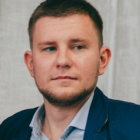 Ilya Kudinov is a journalist from Novosibirsk. Since 2009 he has worked as the investigative coordinator with GIJN member Tak-tak-tak, the Foundation For Promotion of Mass Communication and Education in the Sphere of Law. He specializes in anti-corruption investigations and analysis of human rights violations, and conducts investigative training for journalists and activists.
Ilya Kudinov is a journalist from Novosibirsk. Since 2009 he has worked as the investigative coordinator with GIJN member Tak-tak-tak, the Foundation For Promotion of Mass Communication and Education in the Sphere of Law. He specializes in anti-corruption investigations and analysis of human rights violations, and conducts investigative training for journalists and activists.





